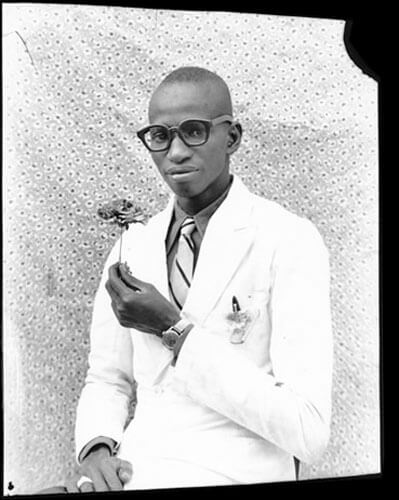The great African portraitist Seydou Keïta lived in Bamako, Mali from 1921 to 2001. A self-taught photographer, he opened a studio in 1948 and specialized in portraiture. Seydou Keïta soon photographed all of Bamako and his portraits gained a reputation for excellence throughout West Africa. His numerous clients were drawn by the quality of his photos and his great sense of aesthetics. Many were young men, dressed in European style clothing. Some customers brought in items they wanted to be photographed with but Keïta also had a choice of European clothing and accessories - watches, pens, radios, scooter, etc. - which he put at their disposal in his studio. The women came in flowing robes often covering their legs and their throats, only beginning to wear Western outfits in the late 60s. Seydou Keïta worked primarily with daylight and for economic reasons took only a single shot for each picture. Seydou Keïta was discovered in the West in the 1990s. His first solo exhibition took place in 1994 in Paris at the Fondation Cartier. This was followed by many others in various museums, galleries and foundations worldwide. He is now universally recognized as the father of African photography and considered one of the greatest photographers of the 20th century. "It’s easy to take a photo, but what really made a difference was that I always knew how to find the right position, and I never was wrong. Their head slightly turned, a serious face, the position of the hands... I was capable of making someone look really good. The "photos were always very good. That’s why I always say that it’s a real art." Seydou Keïta, Bamako, 1995/1996 © André Magnin
From en.wikipedia.orgSeydou Keïta was born in 1921 in Bamako, although the exact date is unknown. He was the oldest in a family of five children. His father Bâ Tièkòró and his uncle Tièmòkò were furniture makers. Keïta developed an interest in photography when his uncle gave him a Kodak Brownie with a film with eight shots in 1935, after returning from a trip to Senegal. In the beginning Keïta worked as both a carpenter and photographer, taking first portraits of his family and friends, later of people in the neighborhood. He learned photography and how to develop from Pierre Garnier, a French photographic supply store owner, and from Mountaga Traoré, his mentor. In 1948 he set up his first studio in the family house in Bamako-Koura behind the main prison.
From www.gallery51.comConsidered to be one the important precursors of African photography, Seydou Keïta was born in Bamako (Mali) in 1920. Like many of his contemporaries, nothing particularly predestined him to become a photographer.
His uncles bring back a camera from a trip to Senegal, and the young Seydou is fascinated. He starts photographing his relatives and discovers a deep passion for this art.
Although he makes furniture for a living, he spends much time with Pierre Garnier who has his own studio. There, Seydou Keïta learns the secrets of the trade and soon realises that there was an enormous demand for individual pictures. This drives him to open his own studio in 1948. Up until then, whites had had a lot of trouble convincing local population to have their pictures taken, because they were so afraid to lose their identity. With Keïta it's different: he is one of them and permits them to choose their own picture that will be left for the close family. From then on, we see the opposite effect: people queue up to have their pictures taken. This is to become the great specialty of the malinese artist. Slowly he develops his own style, in which one finds accents of Mountaga Kouyaté's work, an intellectual that fought a bitter personal battle for the independence of Soedan.
To look their best, that is the sole desire of people in front of Keïta's lens. Keïta even gives them costumes, accessories and furniture to further enhance their appearance.Men, women and children, all look perfectly elegant. If we look beyond the aesthetics of the black-and-white pictures, Seydou shows us a portrait of Malinese society in full transition. Finally Seydou is to become the country's official photographer, and will stop working in 1977. Nevertheless, it will be many years before his work is noted at the famous "Festival of African Photography".
Source: www.seydoukeitaphotographer.com
